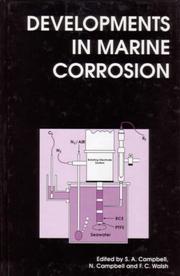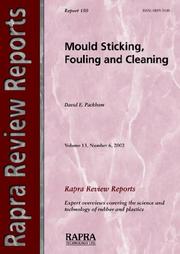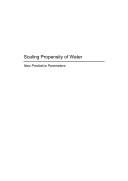| Listing 1 - 10 of 10 |
Sort by
|

ISBN: 1845698762 1855738252 9781845698768 9781855738256 Year: 1998 Publisher: Cambridge, England
Abstract | Keywords | Export | Availability | Bookmark
 Loading...
Loading...Choose an application
- Reference Manager
- EndNote
- RefWorks (Direct export to RefWorks)
The diversity of subjects involved in marine corrosion and fouling processes are evident in the approaches and techniques described in this book. An improvized understanding of biologically influenced corrosion and fouling processes is essential to the development of better corrosion protection systems, and this book shows new perspectives in our appreciation of these subjects. Equally, powerful microscope imaging, surface spectroscopy and electrochemical techniques have become available and are providing new information on metal surfaces experiencing fouling or microbial corrosion. Examples i
Biodegradation --- Fouling --- Biofouling --- Microbial fouling --- Particulate fouling --- Precipitation fouling --- Surfaces (Technology) --- Fouling organisms
Book
ISBN: 3736986068 9783736986060 Year: 2017 Publisher: Göttingen Cuvillier Verlag
Abstract | Keywords | Export | Availability | Bookmark
 Loading...
Loading...Choose an application
- Reference Manager
- EndNote
- RefWorks (Direct export to RefWorks)
Adhesion. --- Fouling. --- Biofouling --- Microbial fouling --- Particulate fouling --- Precipitation fouling --- Surfaces (Technology) --- Fouling organisms --- Adsorption --- Cohesion
Book
ISBN: 1283006154 9786613006158 0080932606 0444532242 9780444532244 Year: 2011 Publisher: Boston : Elsevier,
Abstract | Keywords | Export | Availability | Bookmark
 Loading...
Loading...Choose an application
- Reference Manager
- EndNote
- RefWorks (Direct export to RefWorks)
Industrial Biofouling discusses the the challenges--and to a lesser extent, the benefits--of biofilms on industrial processing surfaces. It addresses the operating problems caused by establishment and growth of microorganisms, thereby enabling effective equipment design and operation that minimizes biofouling. Discusses the chemical and physical control of biofilm growth, with coverage of dosing techniques, equipment cleaning, and cost managementPresents methods for monitoring and evaluating the effectiveness of control techniquesIncorporates explicit
Fouling. --- Industrial water supply. --- Biofilms. --- Microbial aggregation --- Microbial ecology --- Industrial districts --- Industries --- Water-supply, Industrial --- Water-supply --- Biofouling --- Microbial fouling --- Particulate fouling --- Precipitation fouling --- Surfaces (Technology) --- Fouling organisms

ISBN: 128177488X 9786611774882 1859574262 9781859574263 9781859573570 9781859574263 1859573576 Year: 2002 Publisher: Shawbury, U.K. Rapra Technology Ltd.
Abstract | Keywords | Export | Availability | Bookmark
 Loading...
Loading...Choose an application
- Reference Manager
- EndNote
- RefWorks (Direct export to RefWorks)
A large number of objects produced from polymers are moulded. One of the main problems of moulding with polymers is the fact that the articles produced often stick in the mould. An associated problem is that of mould fouling where deposits from previous items stick to the surface of the mould and these in turn cause blemishes on the next product. Mould release and mould fouling have serious implications to the polymer industry in terms of limiting the production rate and in an industry where 'time is money' this can represent a significant cost to that industry. This review first discusses mou
Injection molding of rubber. --- Injection molding of plastics. --- Fouling. --- Biofouling --- Microbial fouling --- Particulate fouling --- Precipitation fouling --- Surfaces (Technology) --- Fouling organisms --- Plastics --- Rubber --- Molding (Chemical technology) --- Molding --- Injection molding
Book
ISBN: 1613247222 9781613247228 9781608765010 1608765016 Year: 2010 Publisher: New York : Nova Science Publishers,
Abstract | Keywords | Export | Availability | Bookmark
 Loading...
Loading...Choose an application
- Reference Manager
- EndNote
- RefWorks (Direct export to RefWorks)
Fouling organisms. --- Fouling --- Hydraulic structures --- Medical instruments and apparatus --- Protective coatings. --- Biofouling --- Microbial fouling --- Particulate fouling --- Precipitation fouling --- Surfaces (Technology) --- Fouling organisms --- Aquatic animals --- Aquatic plants --- Coating compositions --- Coatings --- Corrosion and anti-corrosives --- Sanitary microbiology --- Prevention. --- Protection. --- Microbiology.
Periodical
Abstract | Keywords | Export | Availability | Bookmark
 Loading...
Loading...Choose an application
- Reference Manager
- EndNote
- RefWorks (Direct export to RefWorks)
Marine fouling organisms --- Materials --- Fouling --- Biodegradation --- Environmental Microbiology --- Water Microbiology --- Microbiology, Water --- Water --- Microbiology, Environmental --- Environment --- Biofouling --- Microbial fouling --- Particulate fouling --- Precipitation fouling --- Engineering --- Engineering materials --- Industrial materials --- microbiology --- Surfaces (Technology) --- Fouling organisms --- Engineering design --- Manufacturing processes --- Marine organisms --- Biodegradation. --- Environmental Microbiology. --- Water Microbiology. --- Biodegradation, Environmental. --- Natural Attenuation, Pollution --- Bioremediation --- Phytoremediation --- Environmental Biodegradation --- Pollution Natural Attenuation
Book
ISBN: 0128102594 0128013591 0128012560 1322334692 9780128013595 9780128012567 9780128012567 9780128102596 Year: 2015 Publisher: Waltham, Massachusetts : GPP,
Abstract | Keywords | Export | Availability | Bookmark
 Loading...
Loading...Choose an application
- Reference Manager
- EndNote
- RefWorks (Direct export to RefWorks)
With production from unconventional rigs continuing to escalate and refineries grappling with the challenges of shale and heavier oil feedstocks, petroleum engineers and refinery managers must ensure that equipment used with today's crude oil is protected from fouling deposits Crude Oil Fouling addresses this overarching challenge for the petroleum community with clear explanations on what causes fouling, current models and new approaches to evaluate and study the formation of deposits, and how today's models could be applied from lab experiment to onsite field usability for not just the refi
Petroleum products --- Petroleum --- Contamination (Technology) --- Fouling --- Heavy oil --- Analysis. --- Refining --- Simulation methods. --- Measurement. --- Biofouling --- Microbial fouling --- Particulate fouling --- Precipitation fouling --- Surfaces (Technology) --- Fouling organisms --- Impurities (Technology) --- Industrial contamination --- Particulate contamination in industry --- Factory sanitation --- Coal-oil --- Crude oil --- Oil --- Caustobioliths --- Mineral oils

ISBN: 1780402562 1843390477 Year: 2004 Publisher: London : IWA Publishing,
Abstract | Keywords | Export | Availability | Bookmark
 Loading...
Loading...Choose an application
- Reference Manager
- EndNote
- RefWorks (Direct export to RefWorks)
Water. --- Calcium carbonate. --- Fouling. --- Precipitation (Chemistry) --- Incrustations. --- Deposits, Scale --- Encrustations --- Scale deposits --- Water-formed scale deposits --- Biofouling --- Microbial fouling --- Particulate fouling --- Precipitation fouling --- Fouling --- Separation (Technology) --- Solution (Chemistry) --- Surfaces (Technology) --- Fouling organisms --- Calcium compounds --- Carbonates --- Aragonite --- Calcite --- Limestone --- Marble --- Vaterite --- Hydrology

ISBN: 0849314194 Year: 2004 Publisher: Boca Raton CRC
Abstract | Keywords | Export | Availability | Bookmark
 Loading...
Loading...Choose an application
- Reference Manager
- EndNote
- RefWorks (Direct export to RefWorks)
Fouling. --- Marine fouling organisms. --- Fouling --- Marine fouling organisms --- 574.58 --- 579.262 --- 579.68 --- 581.554 --- 591.553 --- 591.553 Biocoenoses (animal communities) --- Biocoenoses (animal communities) --- 581.554 Colonies. Small groups on otherwise bare areas --- Colonies. Small groups on otherwise bare areas --- 579.68 Microbiology of water. Microbiological characteristics and distribution in natural water --- Microbiology of water. Microbiological characteristics and distribution in natural water --- 579.262 Symbiosis. Communities of microbial cells. Colonies --- Symbiosis. Communities of microbial cells. Colonies --- 574.58 Aquatic biocoenoses --- Aquatic biocoenoses --- Fouling organisms --- Marine organisms --- Biofouling --- Microbial fouling --- Particulate fouling --- Precipitation fouling --- Surfaces (Technology)
Book
ISBN: 3540697942 3642089186 9786611927530 1281927538 3540697969 Year: 2009 Publisher: New York : Springer,
Abstract | Keywords | Export | Availability | Bookmark
 Loading...
Loading...Choose an application
- Reference Manager
- EndNote
- RefWorks (Direct export to RefWorks)
Biofouling is a costly problem, and it is encountered in a wide spectrum of technical systems, ranging from the shipping industry, power industry, water purification, automobile industry, paint and pharmaceuticals, to the microelectronics and food industries. Micro- and macroorganisms attach to surfaces and accumulate there, forming biofilms that cause interferences – a fundamentally natural process. Usually, a medical paradigm is applied: kill biofilms and the problem is solved. This leads to excessive biocide use. However, the success of this strategy is very limited; furthermore it leads to equipment damage and environmental pollution. Simply trying to kill the fouling organisms is clearly not seen as a successful strategy while cleaning is put forward as much more important. In this book, strategies to prevent adhesion, to mitigate the extent and effects of biofouling, and to detect and remove fouling layers are presented. Holistic approaches to the fouling process are elaborated, taking into account options such as nutrient limitation, repellent and easy-to-clean surfaces for fouling layer limitation, and replacing biocides with more environmentally friendly methods – in other words: learning how to live with fouling biofilms without suffering the damage they can do.
Fouling -- Prevention. --- Fouling organisms -- Control. --- Fouling organisms. --- Fouling. --- Industrial water supply. --- Marine biotechnology. --- Industrial water supply --- Fouling --- Fouling organisms --- Marine biotechnology --- Civil & Environmental Engineering --- Biology --- Health & Biological Sciences --- Engineering & Applied Sciences --- Environmental Engineering --- Microbiology & Immunology --- Prevention --- Control --- Biofouling --- Microbial fouling --- Particulate fouling --- Precipitation fouling --- Life sciences. --- Microbiology. --- Applied ecology. --- Microbial ecology. --- Environmental engineering. --- Biotechnology. --- Water pollution. --- Life Sciences. --- Microbial Ecology. --- Applied Ecology. --- Waste Water Technology / Water Pollution Control / Water Management / Aquatic Pollution. --- Applied Microbiology. --- Environmental Engineering/Biotechnology. --- Surfaces (Technology) --- Biotechnology --- Marine biology --- Environmental pollution. --- Chemical engineering --- Genetic engineering --- Chemical pollution --- Chemicals --- Contamination of environment --- Environmental pollution --- Pollution --- Contamination (Technology) --- Asbestos abatement --- Bioremediation --- Environmental engineering --- Environmental quality --- Factory and trade waste --- Hazardous waste site remediation --- Hazardous wastes --- In situ remediation --- Lead abatement --- Pollutants --- Refuse and refuse disposal --- Ecology --- Environmental protection --- Nature conservation --- Microbial biology --- Microorganisms --- Environmental microbiology --- Microbiology --- Environmental aspects --- Environmental control --- Environmental effects --- Environmental stresses --- Engineering --- Environmental health --- Sustainable engineering --- Aquatic pollution --- Fresh water --- Fresh water pollution --- Freshwater pollution --- Inland water pollution --- Lake pollution --- Lakes --- Reservoirs --- River pollution --- Rivers --- Stream pollution --- Water contamination --- Water pollutants --- Water pollution --- Waste disposal in rivers, lakes, etc.
| Listing 1 - 10 of 10 |
Sort by
|

 Search
Search Feedback
Feedback About UniCat
About UniCat  Help
Help News
News